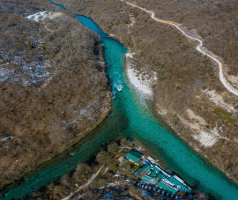Višegrad is a town in eastern Bosnia and Herzegovina (Bosnia). As a child, I would frequently visit this town. Višegrad is struggling with protecting its natural aesthetic and the health and well-being of its inhabitants. The Drina River flows through Višegrad, renowned for its emerald color and historical significance. It symbolizes the struggles of the Bosnian war and underscores urgent environmental and public health challenges requiring immediate intervention.
Before delving into the challenges facing Višegrad today, I would be remiss to not mention and acknowledge the struggles of Bosnia that continue to affect many war-torn families today. Bosnia as a whole has been the victim of unspeakable atrocities and genocide. In 1992, Muslims of Višegrad faced a siege; they were deliberately attacked, tortured, and murdered by Serbs. Serbs, individuals from Serbia, inhabit both Serbia and Bosnia. In Serbia, they operated under the direction of Slobodan Milošević, and in Bosnia, they were led by Radovan Karadžić. They actively promoted Serbian nationalism and pursued the creation of a “…Greater Serbia.” Their goal encompassed the “…disappearance of Bosniaks [Bosnians].” They executed this agenda by ordering Serb forces to “…ethnically purify the territory…” of Bosnian Muslims. The International Criminal Tribunal for the Former Yugoslavia investigated some of the crimes that took place in Višegrad, but many attacks and murders remain unprosecuted. They are unlikely to ever be prosecuted, resulting in zero closure for many families of Višegrad.
As aforementioned, the Drina River flows through Višegrad. The town boasts the Mehmed Paša Sokolović (Sokollu Mehmed Pasha) bridge, designed and built by the Ottoman architect, Mimar Sinan, in the sixteenth century. It spans 179.5 meters in length. Despite being regarded as a historical treasure and even being added to the UNESCO World Heritage List, victims were taken to the bridge and murdered. In 1992, a Višegrad local reported, “They [Serb militiamen] took them [Muslim men] from the trucks and to the railing of the bridges,” and “…they would shoot them,” and throw “…them all into the river.” The war in Bosnia lasted until 1995 when the Dayton Accords were signed. If earlier action had been taken, the staggering loss of 250,000 lives and displacement of over 2 million Bosnians could have been prevented.
You may be asking yourself: How did the war cause the environmental degradation that is still evident today? Is Bosnia taking any action to rebuild its environment? If these questions are on the forefront of your mind, let me pose a simple one: If you witnessed murder and genocide, would rebuilding the green landscape be your top priority? Since scars of the war persist in the region, they have resulted in environmental degradation and even a potential public health crisis.


The Drina River begins at the confluence of the Tara and Piva rivers, flowing for 215 miles until it runs into the Sava river. The Drina serves as a boundary between western Bosnia and eastern Serbia, originating in the northwestern part of Montenegro. Over twenty years ago, individuals built a hydro-power plant with old oil drums to protect the dam from debris that flowed with the river. However, today, after heavy rain and snow, you can nearly find everything under the sun in the Drina. There are reports of finding dead animals, car parts, medical waste, and plastic bottles. The waste can accumulate to around 5,000 cubic meters since garbage flows into Višegrad at least twice a year. The waste piles up behind the barrier that was installed by the hydro-power plant. Consequently, a floating landfill has formed in what was once a picturesque emerald river.


The waste is not generated by the locals of Višegrad, but they are forced to deal with its consequences. The floating landfill results from waste originating in the towns surrounding Višegrad; waste from these surrounding towns flow upstream through the Drina, and accumulate in Višegrad. Despite attempts by workers at the hydro-power plant to clear the waste, Višegrad struggles with an ongoing cycle. Even though they remove and burn 10,000 cubic meters of waste each year in the town’s landfill, the effort has not proven to be highly effective. Fears are materializing not only regarding the river’s ecosystem, but also what the impact will be on locals when the waste is burnt. Burning waste releases toxic chemicals that pollute the air; it is inhaled by both humans and animals, and can also make its way into soil and plants. Ultimately, the toxic chemicals can make its way into the human food chain through crops and livestock.
Fears surrounding the effects on the Drina’s ecosystem are also well-founded. With plastic water bottles being the primary type of waste found in the Drina, many species mistake the waste for food and ingest it; once ingested, it can lead to starvation and/or death. Further, it is no secret that plastic is not fully biodegradable. In fact, the waste can generate even more bacteria and spread disease.
The piled-up waste has drastically harmed the tourism of Višegrad since many tourists make their way to the town to visit the Mehmed Paša Sokolović bridge. It is difficult to market a town that is engulfed with waste that can negatively affect the health of individuals. Since the town heavily relies on outdoor tourism, owners of hotels and restaurants have become devastated and are actively suffering from the sight of the waste.
In March, the Eko Centar Višegrad started taking water samples. However, the problem is long-term, and finding a solution will not be easy nor cheap. It has been proposed that towns upstream of the Drina should implement their own waste collection to prevent the waste from ultimately accumulating in one town, Višegrad.
Although the locals of Višegrad are not currently pursuing any legal actions, it may be worth considering. Whether actions are directed against the government as a whole for failing to implement more effective interventions, or against the surrounding towns that ultimately contribute to the floating landfill, legal action could serve as an effective tool in revitalizing the Drina in Višegrad. However, as Bosnia continues to heal its wounds from the war, it may not be surprising if locals encounter opposition when they express their desire to revitalize a river.
Despite the wounds of the war and the public health challenges that face Bosnia, it continues to strive for healing and renewal. Although locals of Višegrad continue to confront the tragedies of the war whilst facing public health challenges, they take it upon themselves to do it with a commitment of resilience and remembrance. I dream of the moment I can visit an emerald-colored Drina again, but ultimately, a nation whose wounds of the war are healed is something every Bosnian yearns for. Together, we envision a future where peace and prosperity flourish through our green landscape and the Drina River.